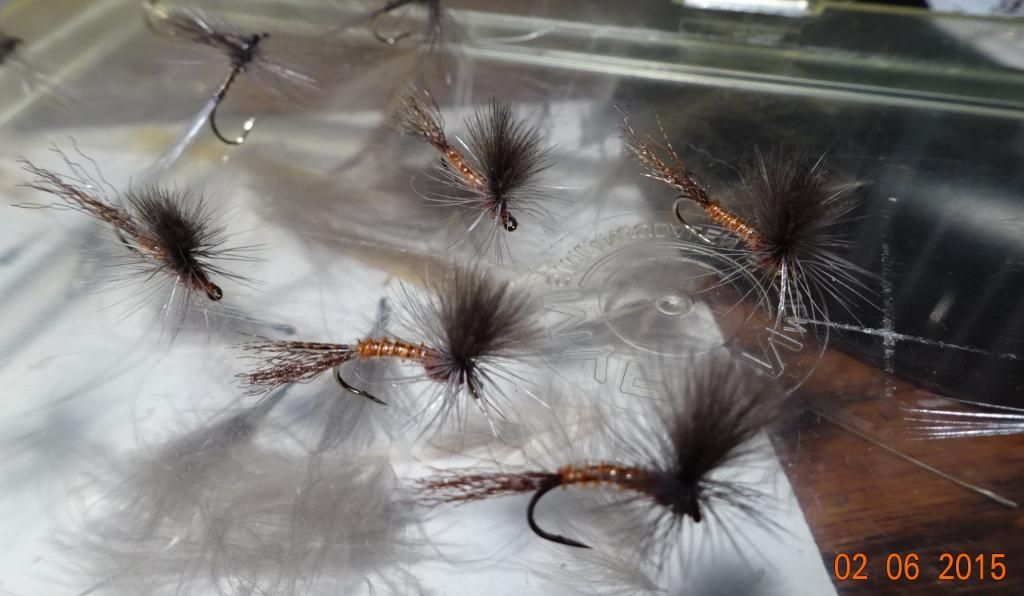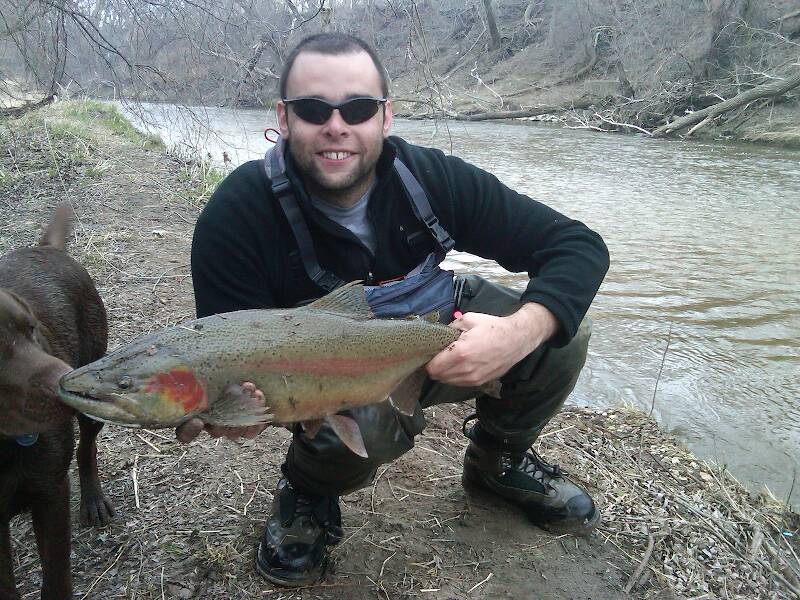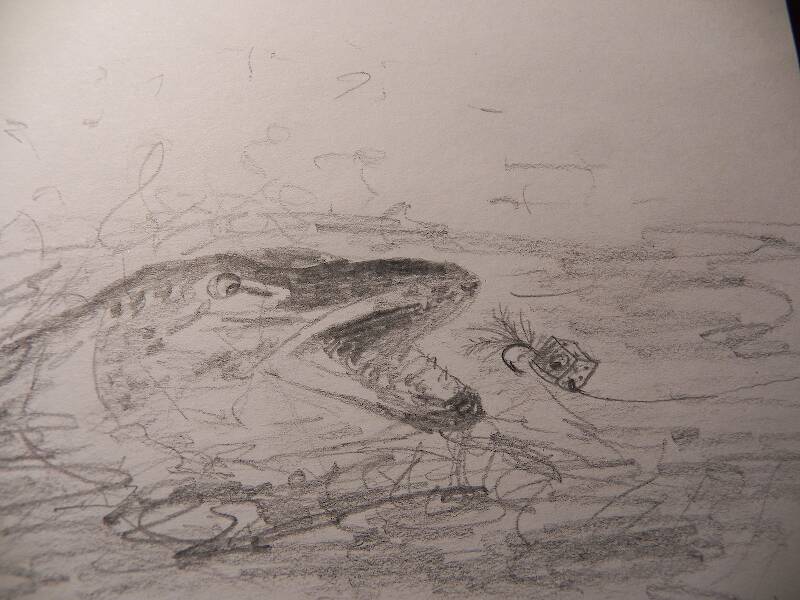
Blue-winged Olives
Baetis
Tiny Baetis mayflies are perhaps the most commonly encountered and imitated by anglers on all American trout streams due to their great abundance, widespread distribution, and trout-friendly emergence habits.
Featured on the forum

This specimen appears to be of the same species as this one collected in the same spot two months earlier. The identification of both is tentative. This one suffered some physical damage before being photographed, too, so the colors aren't totally natural. I was mostly photographing it to test out some new camera setting idea, which worked really well for a couple of closeups.

Troutnut is a project started in 2003 by salmonid ecologist Jason "Troutnut" Neuswanger to help anglers and
fly tyers unabashedly embrace the entomological side of the sport. Learn more about Troutnut or
support the project for an enhanced experience here.
Wbranch on Feb 7, 2015February 7th, 2015, 2:10 pm EST
I have never had very much confidence in tying parachutes because I never knew how to tie off the hackle so fibers wouldn't get stuck under the thread. So for one of my New Years resolution I promised myself I would learn to tie them as well as I can tie any other dry fly. I'd appreciate any comments and critiques regarding my progress to tie parachutes better. I'm starting off with #12 & #14 and am going to work my way down to #16 & #18. Thanks!






Catskill fly fisher for fifty-five years.
TNEAL on Feb 7, 2015February 7th, 2015, 4:53 pm EST
with my left hand (I'M right-handed) I pull all the hackle back out of the way and tie off; repeat the process to whip finish. Some say this gives the hackle a beating; I say it happens twice for a few brief seconds. Any fish will give it a much worse beating in the playing and landing process.
Jmd123 on Feb 8, 2015February 8th, 2015, 9:12 am EST
Matt, those look most fine to me! My favorite parachute pattern in the Parachute Royal Coachman - of course, because I am so fond of the Royal Wulff...BTW, what pattern are those? Looks a bit like a Red Quill to me.
Jonathon
Jonathon
No matter how big the one you just caught is, there's always a bigger one out there somewhere...
Wbranch on Feb 8, 2015February 8th, 2015, 10:59 am EST
Yrs, Red Quill, with turkey biot body, xf gold wire rib. fur thorax, CDC wings and medium dun Whiting saddle hackle.
Catskill fly fisher for fifty-five years.
TNEAL on Feb 8, 2015February 8th, 2015, 3:24 pm EST
Nicely done.
Feathers5
Posts: 287
Posts: 287
Feathers5 on Feb 9, 2015February 9th, 2015, 3:53 am EST
I tie my hackle off at the post. After a little practice it became easy, and my flies looked much better, although I'm not the greatest fly dresser.
Wbranch on Feb 9, 2015February 9th, 2015, 8:29 am EST
Feathers5,
Would you be able to explain what you mean by that?
I tie my hackle off at the post.
Would you be able to explain what you mean by that?
Catskill fly fisher for fifty-five years.
Feathers5
Posts: 287
Posts: 287
Feathers5 on Feb 9, 2015February 9th, 2015, 8:48 am EST
I'll try. Instead of whip finishing at the eye I do it around the post.
I tie in my tails;
tie in the wing post, I used poly pro last night;
dub the body to the post;
attach hackle to the post;
then dub to the eye of the hook and back to the post;
with my thread at the post I wind the hackle around post;
I then tie in the hackle around the post with my thread;
once hackle is secured I perfrom a whip finish around the post.
By doing it this way and I don't have to worry about pulling fiber aways from the hook eye to whip finish thefly. I don't think this is my idea, although it could have come to me in a dream. i can't remember why I began doing it this way. I must have seen it somewhere.
I hope you are able to understand this.
I tie in my tails;
tie in the wing post, I used poly pro last night;
dub the body to the post;
attach hackle to the post;
then dub to the eye of the hook and back to the post;
with my thread at the post I wind the hackle around post;
I then tie in the hackle around the post with my thread;
once hackle is secured I perfrom a whip finish around the post.
By doing it this way and I don't have to worry about pulling fiber aways from the hook eye to whip finish thefly. I don't think this is my idea, although it could have come to me in a dream. i can't remember why I began doing it this way. I must have seen it somewhere.
I hope you are able to understand this.
Kschaefer3 on Feb 9, 2015February 9th, 2015, 9:15 am EST
I'll try. Instead of whip finishing at the eye I do it around the post.
I tie in my tails;
tie in the wing post, I used poly pro last night;
dub the body to the post;
attach hackle to the post;
then dub to the eye of the hook and back to the post;
with my thread at the post I wind the hackle around post;
I then tie in the hackle around the post with my thread;
once hackle is secured I perfrom a whip finish around the post.
By doing it this way and I don't have to worry about pulling fiber aways from the hook eye to whip finish thefly. I don't think this is my idea, although it could have come to me in a dream. i can't remember why I began doing it this way. I must have seen it somewhere.
I hope you are able to understand this.
I am by no means good at parachutes, but the few I've tied have been exactly as you describe here. One video I watched, the gentleman actually took the hook out of the vise after dubbing the thorax, right as he was about to wrap the hackle, and re-positioned it in the vise with the post parallel to his tying bench. I found it to be a touch easier to whip finish this way, but that was the only benefit imo.
Martinlf on Feb 9, 2015February 9th, 2015, 9:17 am EST
Bruce, Hans van Klinken does it this way. Here another Hans ties a Klink:
https://www.youtube.com/watch?v=VQwM70MzgVo
I tie my parachutes this way too, though I use a whip finish tool. I've taken to putting a bit of brush on Zap a Gap on the thread before whip finishing. I used to use a micro drop of Gorilla glue. Either locks the thread to avoid slippage.
If you are right handed and wrap the hackle clockwise, a clockwise whip finish tightens the wraps.
https://www.youtube.com/watch?v=VQwM70MzgVo
I tie my parachutes this way too, though I use a whip finish tool. I've taken to putting a bit of brush on Zap a Gap on the thread before whip finishing. I used to use a micro drop of Gorilla glue. Either locks the thread to avoid slippage.
If you are right handed and wrap the hackle clockwise, a clockwise whip finish tightens the wraps.
"He spread them a yard and a half. 'And every one that got away is this big.'"
--Fred Chappell
--Fred Chappell
Wbranch on Feb 9, 2015February 9th, 2015, 10:40 am EST
Hello Louis,
I watched that little video and really enjoyed seeing how he ties off the hackle. It was easy for him to do a couple wraps under the hackle barbs and he made it look pretty easy to apply the half hitches. I think that will be a bit of a problem but I think in time it might cause me less angst. I like how my parachutes look but I do get nervous and tense tying them off.
One step I saw that I haven't been doing is to make repetitive thread wraps around the base of the post. I'm not sure what the purpose of that is - can anyone tell me? I've just been wrapping the hackle around the base of the CDC wings.
I watched that little video and really enjoyed seeing how he ties off the hackle. It was easy for him to do a couple wraps under the hackle barbs and he made it look pretty easy to apply the half hitches. I think that will be a bit of a problem but I think in time it might cause me less angst. I like how my parachutes look but I do get nervous and tense tying them off.
One step I saw that I haven't been doing is to make repetitive thread wraps around the base of the post. I'm not sure what the purpose of that is - can anyone tell me? I've just been wrapping the hackle around the base of the CDC wings.
Catskill fly fisher for fifty-five years.
Kschaefer3 on Feb 9, 2015February 9th, 2015, 11:07 am EST
One step I saw that I haven't been doing is to make repetitive thread wraps around the base of the post. I'm not sure what the purpose of that is - can anyone tell me? I've just been wrapping the hackle around the base of the CDC wings.
Martinlf on Feb 9, 2015February 9th, 2015, 11:11 am EST
Matt, do you mean thread wraps before you wrap the hackle? If so, some folks like to reinforce and stiffen a post, especially one made of something soft such as poly yarn, to provide a more rigid base for wrapping the hackle. I tie some very small parachutes with a post more for a bit of visibility than to mimic a wing. These posts may consist of just a few strands (perhaps 10?) of poly yarn. I'll wrap up this post a bit with the thread to stiffen the post before wrapping the hackle. Sometimes if you throw the wraps at the base of the post each previous wrap will climb the post as you add them below. Perhaps this is what you have seen. With your CDC posts you have some stem in there to provide plenty of stiffness and I'd think you wouldn't need any further stiffening. Oh, and tying off on the post below the hackle does take a little practice, but it's easy once you decide on a method and get used to it. IMHO it makes for an easier, tighter, and neater approach, but, of course, some beg to differ.
"He spread them a yard and a half. 'And every one that got away is this big.'"
--Fred Chappell
--Fred Chappell
Wbranch on Feb 9, 2015February 9th, 2015, 12:06 pm EST
Louis,
"Matt, do you mean thread wraps before you wrap the hackle?"
Yes, after the yarn post was affixed the guy ran a bunch of thread wraps around and up the yarn. It appeared to be about 10 - 12 thread wraps. So far my wings seem to be providing adequate support for the hackle but the true test will be how does it hold up after my aggressive casting.
"Matt, do you mean thread wraps before you wrap the hackle?"
Yes, after the yarn post was affixed the guy ran a bunch of thread wraps around and up the yarn. It appeared to be about 10 - 12 thread wraps. So far my wings seem to be providing adequate support for the hackle but the true test will be how does it hold up after my aggressive casting.
Catskill fly fisher for fifty-five years.
RMlytle on Feb 11, 2015February 11th, 2015, 11:39 am EST
Good ties. I had problems with parachutes for the longest time. I eventually just began to clip the excess hackles as tightly as possible before covering that sloppiness up with dubbing. Works just fine for me! The trout don't seem to care.
Oldredbarn on Feb 11, 2015February 11th, 2015, 7:37 pm EST
Yes, after the yarn post was affixed the guy ran a bunch of thread wraps around and up the yarn. It appeared to be about 10 - 12 thread wraps. So far my wings seem to be providing adequate support for the hackle but the true test will be how does it hold up after my aggressive casting.
Matt...This "posting" process where you wrap up and down the post a bit makes everything a bit easier and more durable. Some guys dab a bit of glue here, but it's probably overkill.
The style that Louis shows Hans doing is interesting and I have done that for quite some time on some of my parachute flies. Hans uses "spider wire" I think its called and it is a very thin thread and is white. It is kind of neat in that you can tie the complete fly (using whatever thread you normally would use) right up to just before you wrap the hackle, whip finish it and lay it aside...Then crank out another one up to that point...
So you have a dozen or so flies sitting there, finished save for wrapping the hackle, then do as mentioned above, I think in Kyles post, put the hook in the vise with your post pointing straight out to your right, bend up, eye down. Attach the spider wire near the top of where you posted thread and wrap down the post to the hook.
Important side note: Hans trims a longer bit of the stem on the hackle and ties it up, in the posting process, up against the post. So when you start to wrap the hackle you bend it over and the first wrap is at the top, and you wrap down to where you left the thread and then wrap it against the post. You can then whip finish at this point and snip off the hackle and thread...If you practise I have even used the whip finish tool and wrapped around the post underneath the wrapped hackle.
I just re-read this and it sounds scrambly, but it works and its too late for me to try and edit it...:) I'm off to bed.
Spence
Oh! Your flies look fine. :)
"Even when my best efforts fail it's a satisfying challenge, and that, after all, is the essence of fly fishing." -Chauncy Lively
"Envy not the man who lives beside the river, but the man the river flows through." Joseph T Heywood
"Envy not the man who lives beside the river, but the man the river flows through." Joseph T Heywood
Martinlf on Feb 12, 2015February 12th, 2015, 6:38 am EST
Spence, I've been using Veevus thread in smaller sizes instead of spider wire. I tie the whole fly with the Veevus, and use it for the whip finish. It's incredibly strong and thin, and it makes a great whip finish, with no need to stop before you're completely done.
"He spread them a yard and a half. 'And every one that got away is this big.'"
--Fred Chappell
--Fred Chappell
Afishinado on Feb 13, 2015February 13th, 2015, 3:00 am EST
Back in the early 90's I hooked up with guide that was a tyer for Blue Ribbon in West Yellowstone. He was sitting down tying parachutes when I walked in the shop. He tied them in a unique way (at least to me). He tied the entire fly: tail, post and body whip-finished the head to finish the fly.
He turned the fly in the vise hook eye up and attached the hackle feather on the post, wound the hackle down the post towards the body and whip finished the fly to complete it.
When I tried it, I found winding the hackle and whip-finishing it was much easier to do vertically, with the hook pointed up, rather than horizontally.
Also attaching the stem of the hackle feather on the post stiffens it, making it easier to wind on the hackle without it collapsing.
One final step, before I do the final whip-fishing on the post, I apply a little head cement to the thread to seal the deal.
I've been tying my parachutes that way since then with really good results.
He turned the fly in the vise hook eye up and attached the hackle feather on the post, wound the hackle down the post towards the body and whip finished the fly to complete it.
When I tried it, I found winding the hackle and whip-finishing it was much easier to do vertically, with the hook pointed up, rather than horizontally.
Also attaching the stem of the hackle feather on the post stiffens it, making it easier to wind on the hackle without it collapsing.
One final step, before I do the final whip-fishing on the post, I apply a little head cement to the thread to seal the deal.
I've been tying my parachutes that way since then with really good results.
Entoman on Feb 13, 2015February 13th, 2015, 5:18 pm EST
There are 4 basic ways to tie parachutes without the complications of the gyro style tied since the 30's. S & R style, Quigley style, Klinkhammer style, and AK Best style.
The Cliff's Notes comparison:
S & R - wrapped counter clockwise around the unsupported post and tied off at the head. This style floats high and is the quickest to execute. The lack of supporting wraps on the post allows it to flair more and results (depending on post material) in blending more with the hackle resulting in a finished fly where the area that the post begins and the hackle ends is more obscure. The hackles are usually pulled back severely to avoid trapping when finishing the head. They are also generally less durable.
Quigley - similar to the S & R but with a supported post and a more prominent thorax. Properly tied, there is a small band of supported post at the top uncovered by hackle wraps. The hackles are tied off at the head without bending back by pulling the bobbin tight to the head. Incredibly durable, no broken hackle spines. The best technique for imitating duns, IMO
Klinkhammer - hackle wrapped clockwise and tied off at the base of the post. Unless Spider thread is used the result is an elevated hackle well above the body. The cleanest heads (or no heads) are achieved this way but at the expense of either bent hackles (to finish off the thorax) or requiring double thread attachments. The best technique for low floating emerger types, again IMO.
AK Best style - unique in that it breaks convention and wraps hackle clockwise for tying off at the head. This allows for very close tie off at the base of the post. Wrapping across the hackle at tie off can be a bit tricky security wise and requires severely bent hackle at the finish to avoid trapping barbules. This technique is best for pure quill bodied flies without a dubbed thorax and has the post mounted the farthest forward. The post is supported heavily so it is durable. If a wing closer to the eye isn't objectionable and if the practice (by analogy) of pulling the barbules and wings tightly against the hook shank to finish off the head of a Catskill tie doesn't make you shudder, this is perhaps the method for you.
The Cliff's Notes comparison:
S & R - wrapped counter clockwise around the unsupported post and tied off at the head. This style floats high and is the quickest to execute. The lack of supporting wraps on the post allows it to flair more and results (depending on post material) in blending more with the hackle resulting in a finished fly where the area that the post begins and the hackle ends is more obscure. The hackles are usually pulled back severely to avoid trapping when finishing the head. They are also generally less durable.
Quigley - similar to the S & R but with a supported post and a more prominent thorax. Properly tied, there is a small band of supported post at the top uncovered by hackle wraps. The hackles are tied off at the head without bending back by pulling the bobbin tight to the head. Incredibly durable, no broken hackle spines. The best technique for imitating duns, IMO
Klinkhammer - hackle wrapped clockwise and tied off at the base of the post. Unless Spider thread is used the result is an elevated hackle well above the body. The cleanest heads (or no heads) are achieved this way but at the expense of either bent hackles (to finish off the thorax) or requiring double thread attachments. The best technique for low floating emerger types, again IMO.
AK Best style - unique in that it breaks convention and wraps hackle clockwise for tying off at the head. This allows for very close tie off at the base of the post. Wrapping across the hackle at tie off can be a bit tricky security wise and requires severely bent hackle at the finish to avoid trapping barbules. This technique is best for pure quill bodied flies without a dubbed thorax and has the post mounted the farthest forward. The post is supported heavily so it is durable. If a wing closer to the eye isn't objectionable and if the practice (by analogy) of pulling the barbules and wings tightly against the hook shank to finish off the head of a Catskill tie doesn't make you shudder, this is perhaps the method for you.
"It's not that I find fishing so important, it's just that I find all other endeavors of Man equally unimportant... And not nearly as much fun!" Robert Traver, Anatomy of a Fisherman
Wbranch on Feb 13, 2015February 13th, 2015, 5:34 pm EST
Kurt,
Now that is a great explanation of various methods to wrap and tie off hackle for parachutes. I like the idea of pulling the bobbin up tight to the head. Do you mean wind up the thread on the bobbin so the tube is very close to the eye of the hook? That sounds like it would make it easier for the thread to get under, and clear, the barbules.
I watched a YouTube video the other night where the guy didn't tie off in the conventional sense at all. After he wraps clockwise he finishes the wraps in the rear of the post. Then he brings the thread under the barbules to catch the stem of the hackle. He holds the bobbin tight in his right hand and with his left hand he takes a thin bobbin needle and dips on a tiny drop of Krazy Glue and applies it right to the thread and the post.
Here is a link to that video. It is pretty cool.
https://www.youtube.com/watch?v=ob-m5XXhdJY&feature=em-share_video_user
He said it never comes apart.
Now that is a great explanation of various methods to wrap and tie off hackle for parachutes. I like the idea of pulling the bobbin up tight to the head. Do you mean wind up the thread on the bobbin so the tube is very close to the eye of the hook? That sounds like it would make it easier for the thread to get under, and clear, the barbules.
I watched a YouTube video the other night where the guy didn't tie off in the conventional sense at all. After he wraps clockwise he finishes the wraps in the rear of the post. Then he brings the thread under the barbules to catch the stem of the hackle. He holds the bobbin tight in his right hand and with his left hand he takes a thin bobbin needle and dips on a tiny drop of Krazy Glue and applies it right to the thread and the post.
Here is a link to that video. It is pretty cool.
https://www.youtube.com/watch?v=ob-m5XXhdJY&feature=em-share_video_user
He said it never comes apart.
Catskill fly fisher for fifty-five years.
Quick Reply
Related Discussions
Topic
Replies
Last Reply
6
Sep 11, 2020
by Martinlf
by Martinlf
Re: Three Trouble Makers at the Midwest Fly Fishing Expo the past weekend

In the Photography Board by Oldredbarn

In the Photography Board by Oldredbarn
3
Mar 11, 2014
by TNEAL
by TNEAL








